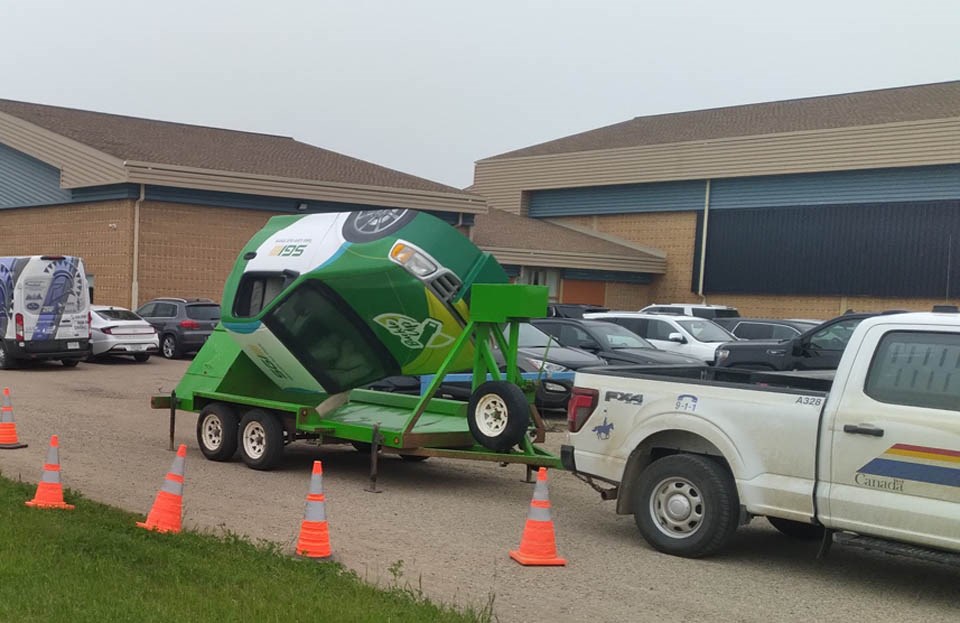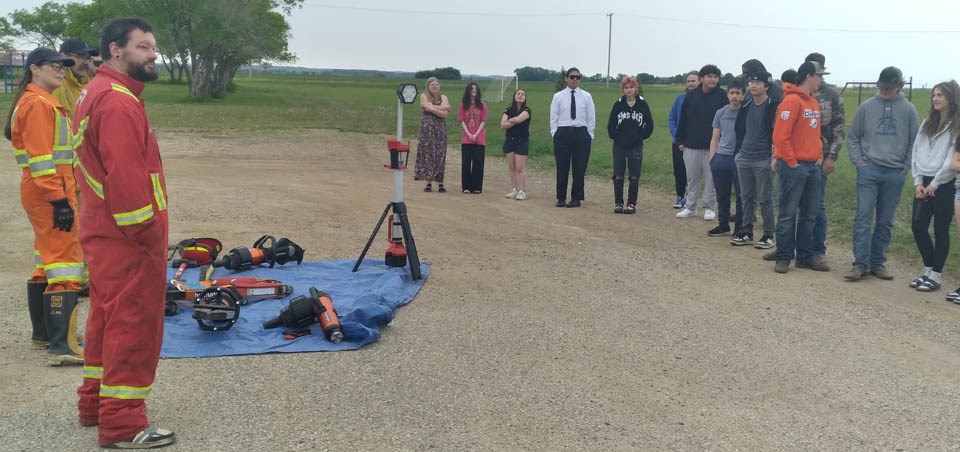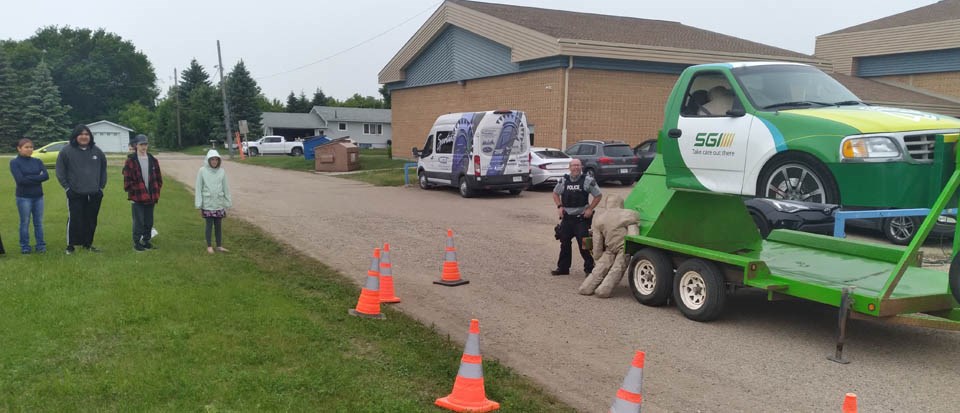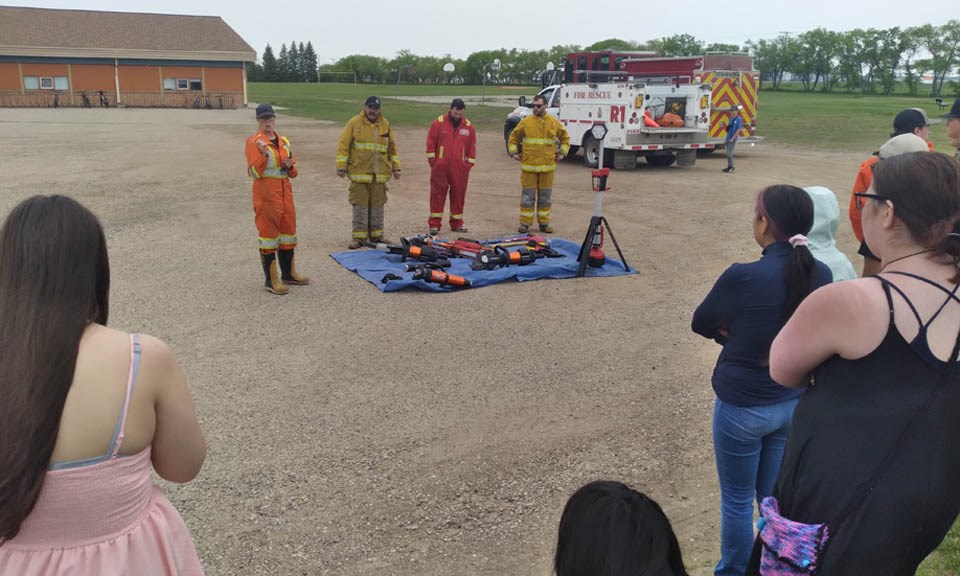KAMSACK — Facilitated by the Kamsack Comprehensive Institute’s SADD (Students Against Drinking and Driving), SGI’s rollover simulator was at the school June 13, demonstrating what happens in a rollover vehicle accident when occupants wear and don’t wear seatbelts.
The equipment was operated by Cst. Dylan Custaloe, who is the RCMP liaison with the KCI SADD group and as students gathered around the simulator, the equipment was powered to spin round, showing what happens to the dummies in the cab when wearing seatbelts, and what can happen to the bodies when not wearing seatbelts, including allowing them to be thrown around the cab, and even partially out the windows.
Following the demonstration, members of the Kamsack fire brigade demonstrated the use of tools used to free persons from an accident scene, including a splitter, cutter and spreader (also called the Jaws of Life).
The Kamsack fire department applied for funding from the Saskatchewan Public Safety Agency (SPSA) for the Transportation Rescue Extrication (TREX) Program, which provides auto extraction training and equipment, said Ken Thompson, fire chief. Last year, the department received $60,000 worth of tools in the program.
Firefighter Mike Fernuik, who trains fellow brigade members in the use of the extrication equipment, and Mike Covic, another member of the brigade, showed the students how the various equipment is used in an accident scenario.
Pam Rose of the brigade demonstrated the use of a device that, in an emergency, can be used for cutting seatbelts and smashing a vehicle’s windows, allowing persons to better exit a vehicle following an accident.
“This is my favourite tool,” Rose said as she produced the device, which can be as small as a writing pen. She urged all vehicles to carry one of the small, inexpensive devices.
Buckling up a seatbelt can save the life of one out of two people who are involved in a collision, according to information from the SGI website. “We can demonstrate how seatbelts save lives with our rollover simulator.”
The simulator is the cab of a Ford F150 mounted on a spinner, which rolls the cab, simulating a rollover incident, the information said. “Dummies are placed inside the simulator to demonstrate the importance and effectiveness of wearing a seatbelt in the event of a rollover collision.

The SGI rollover simulator was spun around as students watched the effects on the dummies restrained with seatbelts inside the cab. | Photos by William Koreluik
The simulator is run three times: once with both dummies using a seatbelt, the second with only the passenger dummy wearing a seatbelt and a third time with both “occupants” unrestrained.
As part of its traffic safety education program, SGI has partnered with the RCMP to take the simulator on the road to rural high schools, First Nations communities, trade fairs, malls and other community events, it said.

Students of the KCI watched as Kamsack firefighters demonstrated the use of various extrication devices that can be used at the scene of a traffic accident.
In Saskatchewan, on average (2019-2023), there are 3,480 collisions per year attributed to driver distraction, the SGI site says. These collisions resulted in 15 fatalities and 754 injuries.
Driver inattention and distraction are among the leading causes of collisions.

Cst. Dylan Custaloe of the Kamsack RCMP, who is the RCMP liaison with the KCI SADD group, stood alongside a dummy that was not restrained by seatbelts and was nearly thrown out of the cab.
Statistics show that seatbelts can decrease the chances of being seriously injured in a traffic crash by as much as 50 per cent, it says. Twelve unbelted vehicle occupants were killed in 2019 in Saskatchewan, which equals 20.7 per cent of vehicle occupants killed in automobile crashes.
Seatbelts were not used by 38 of the 344 people seriously injured in 2019, it said. Thirteen people were killed in single-vehicle rollovers in 2019; of those, 54 per cent (seven of 13) were not wearing a seatbelt.
In 2019, drivers aged 15 to 18 represented 5.1 per cent of the licensed drivers and accounted for 6.7 per cent of drivers involved in collisions. For the overall population, there are 50 collisions per 1,000 licensed drivers. This number increases to 66 collisions per 1,000 licensed drivers between 15 to 18 years of age.
In 2019, drivers 65 and older represented 19.2 per cent of the licensed drivers in Saskatchewan and they accounted for 10.1 per cent of drivers in collisions.
There were 142 traffic collisions involving a motorcycle, resulting in 95 injuries and five deaths in 2019 in Saskatchewan.
More than 80,000 children ride school buses every day in Saskatchewan. In 2019, there were 18 casualty collisions involving school buses, resulting in one injury to an adult woman.
In 2019, a total of 110 cyclists were injured as a result of a traffic collision.
In 2019, there were 71 children six years of age or younger injured and one killed while riding in a vehicle, the SGI website says. Five of those children were not restrained or were restrained improperly. In addition, 12 of those children were wearing a seatbelt that may have been inappropriate for them.
The TREX Program is supported by one-time funding of $5.6 million from SGI and administered by the SPSA, according to information from SPSA.
“Comprehensive programs like TREX ensure that firefighters in Saskatchewan have the skills and tools needed for safer and more efficient responses,” said Marlo Pritchard, SPSA President and Fire Commissioner. “The training provided will improve the safety of Saskatchewan residents and the firefighters responding to motor vehicle collisions.”
The first of its kind in Canada, the TREX Program was developed in collaboration with the Saskatchewan Volunteer Fire Fighters Association (SVFFA), the Saskatchewan Association of Fire Chiefs (SAFC) and the Provincial Training Standards Committee, the information said. The program's objectives are to: enhance capacity for fire departments to respond to motor vehicle collisions through the provision of funded training and equipment; ensure participating fire departments can maintain their response levels by having set program criteria, and provide the SPSA and SGI with the ability to measure program success for a minimum of five years once each participating community enters the maintenance phase of the program.
"Volunteer firefighters are often first on the scene of collisions in rural Saskatchewan, so it's vital they have the training and equipment they need," said Don Morgan, Minister Responsible for SGI. “As vehicle technology advances, this program will continue to support their ability to respond to collisions safely and effectively.”
The SPSA facilitated mass training events for fire departments that do not have the capacity to hold their own training as required by the TREX Program guidelines and vendors.




